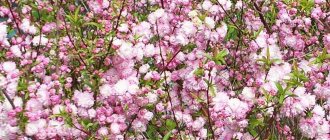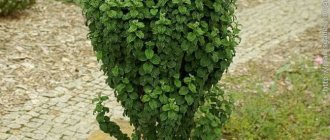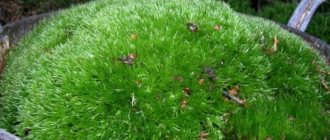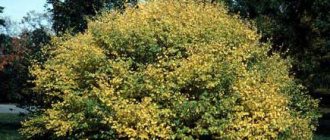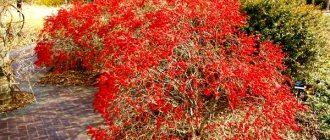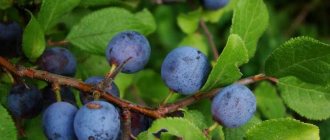- October 20, 2018
- Trees and shrubs
- Julia Master
The almond bush is rightfully considered by gardeners to be one of the most beautiful ornamental shrubs. Its abundant flowering occurs in April-May, during this period it is the main decoration of the garden. There are many varieties of almonds, differing in flower color and flowering period.
Botanical description
Almond (lat. Amygdalus) is an ornamental shrub or tree from 1 to 6 m high, belongs to the Rosaceae family and is a relative of fruit trees (apricot, plum, cherry, etc.). It belongs to the stone fruit crops, although it has fruits in the form of nuts. Ordinary almonds are divided into 2 types: bitter and sweet. The fruits of its wild species are not eaten due to the content of hydrocyanic acid in the kernels - this species is grown for the production of medicines.
For many centuries, this beautifully flowering and fertile plant grew in the Mediterranean and Central Asia. Now almond planting has spread to several continents, from Europe, China to the USA. In the wild, almonds grow in groups at an altitude of up to 1.6 km. In Russia, the almond bush has become widespread in the southern regions.
Difficulties in growing Louiseania
Double plum is a hardy plant. The shrub is affected by diseases and attacked by insects only with poor care or changes in external conditions.
Insects that attack Louiseania
Most often, Louiseania is attacked by aphids. Concentrated infusions of tobacco, celandine or a solution of laundry soap will save you from the pest. If folk remedies do not help, use insecticidal preparations, which are prepared according to the instructions. Sometimes the bush is attacked by a leaf roller. Folk remedies are used against the insect, hunting belts and traps with leftover beer or kvass are installed. The caterpillars of this pest are collected by hand and birds are attracted by installing feeders.
Spraying with a one percent solution of karbofos helps against plum moth (the procedure is carried out twice, after 14 days). The plum bark beetle spoils the bark of Louiseania, which is fraught with the appearance of fungal diseases. The passages on the shoots and the shoots themselves are covered with a product consisting of clay, lime and wood glue.
Louiseania diseases
Aflatunia vyazolifolia can be affected by fungal diseases. To prevent rust, the foliage of the bush is dusted with sulfur powder or sprayed with a solution of colloidal sulfur. To prevent the development of gray rot, after the flowering period ends, branches damaged by the fungus are cut off. Pruning is carried out until the pads appear, in which spores form. Louiseania is treated with Bordeaux mixture twice a season against moniliosis.
In the southern regions, fruit bushes are sometimes affected by milky sheen, a rare infection caused by a fungus. First, young leaves become covered with silvery spots. Then the leaf blades become brown, the edges dry out and curl. Brown spots are visible on the cut shoots. To prevent biomycosis, maintain the required distance between planted plants.
Important! Plant debris affected by fungus should not be left near the tree trunk area or placed in compost. This can lead to re-infection of the treated crop and the appearance of biomycosis in other plants. Cut branches must be burned. The cut areas on the branches are treated with a disinfectant, and the trunk of the bush is whitened.
Fruits and their uses
The plant is valuable not only for its decorative qualities, but also for its tasty and healthy fruits - almonds. The fruits usually ripen in summer (June-July); in appearance they look like pubescent drupes covered with gray-green hair. Inside the thin shell is a seed (nut) up to 2 cm in size, having a rounded shape on one side and a sharp tip on the other.
Almond nuts are widely used in cosmetology and medicine; they are used in therapeutic diets and for weight loss. In cooking, the fruits are very popular for making cakes, pastries and other desserts. Almonds are used in the production of alcoholic beverages.
Selecting a site for planting
Before planting an almond plant on your site (photo below), you should choose a suitable place for it. In order for the plant to be healthy and bloom abundantly, it needs a space protected from wind and drafts, and a large amount of sun. Almonds do not tolerate shade, so the southern part of the site, which is well lit all day, will be optimal.
The shrub does not have any special requirements for the soil, but prefers sandy loam or light loamy soils that have a good supply of nutrition (preferably fertilized with compost). Groundwater should not come close to its roots: if an area on clay soil is flooded, the plant will die. The soil must be non-acidic, pH = 4.5-7.5, otherwise it is better to neutralize it by adding lime.
A type of almond that grows in the north
This tree came to us from China. They call it differently there. Some say that this is a Chinese cherry tree - sakura. This happened relatively recently - only about 100 years ago. But to this day, almonds are considered exotic in our area. What is its peculiarity?
Almonds in Siberia are a real curiosity. Many have not even heard that this tree is very resistant and is ideal for the harsh conditions of Siberia. There is even an opinion that it is impossible to grow almonds in this area without additional shelter for the winter season.
Surprisingly, almonds will take root even in a winter of minus 30 degrees. There are many different varieties of this shrub. Their number includes up to 40 species. Everyone knows that almonds love the sun, warmth and do not tolerate drafts. But there is one variant of such a shrub that can exist even in the northern regions. Its name is steppe almond or bean. Common names include almond, wild or low almond.
In addition, there are two more varieties of almonds that are resistant to low temperatures, but are not suitable for the north:
- Georgian almonds;
- Petunnikov bush.
Reproduction
Ornamental almond shrubs can be propagated in several ways:
- Division, in which a very overgrown bush can be divided into several parts, which are planted separately.
- Root shoots, which often grow after the next pruning of branches, are planted in the second year after the formation of a good root system.
- Cuttings are carried out after preliminary preparation: cuttings are cut out in July, selecting parts with 2-3 nodes; when planting, they are buried, leaving only one on top of the soil; During the first wintering, the plantings must be insulated with straw or leaves.
- Layering - done by bending shoots to the ground, which are sprinkled with earth; after the roots appear (after 1 year), the layering can be separated and planted.
- Propagation by seeds is carried out in the fall, immediately after collecting almonds from the bush, planted to a depth of 8 cm, and also in the spring - to a depth of 6 cm, making preliminary stratification.
- Almonds can be grafted onto sloe, cherry plum or plum bushes, after which budding is done in mid-summer.
Care
Three-lobed almonds are an adapted exotic plant that can adapt to life in the middle zone. The shrub is unpretentious, but in order for it to develop properly and bloom beautifully, certain agrotechnical conditions must be observed.
Watering
Louiseania is a drought-resistant plant. When caring for shrubs, you should avoid stagnation of moisture in the soil, waterlogging and drops of water falling on the crown. These factors can cause rotting of the root system and neck of Louiseania and contribute to the development of fungal diseases. Water the plant when the surface of the soil dries 30 mm. The bush needs water most before and during flowering. The rest of the time, the frequency of watering depends on the composition of the soil: clay soil is moistened less frequently than sandy soil.
Top dressing
After flowering, the shrub is fed with organic fertilizers. 15 days after this feeding, the plant is watered with a urea solution (10 g of granules are dissolved in 10 liters of settled water). In autumn, the soil under Louiseania is irrigated with ash infusion (1 cup of fertilizer is dissolved in a bucket of water). 50 g of superphosphate is added to the tree trunk area and mixed with the soil using a rake or flat cutter.
Shrub pruning
Starting from the age of two, the shrub needs annual pruning. Using the procedure, the plant is healed and the crown is formed. At the very beginning of spring, frozen and dried branches are cut off. After flowering, Louiseania shoots are shortened, leaving 1/3 of the length. During the summer season they will grow back, and next year flowering will resume with renewed vigor. Be sure to cut off branches growing deep into the bush to improve access of light and air to the shoots and to avoid the development of diseases.
Read how to use hydrangea for landscape design and how to propagate hydrangea by cuttings in the fall.
Preparing for winter
Louiseania does not tolerate sharp temperature fluctuations, which are often observed during the changing seasons and during the cold season. To make the transition from frost to sudden warming less painful, the plant is covered for the winter:
- the shoots are collected into a loose bundle and carefully tied;
- the prepared crown is covered with dense non-woven material;
- the root zone is sprinkled with a thick layer of soil or peat (at least 0.15 m).
The basal neck of the bush is not buried. To save three-lobed almonds from rodents, the lower part of the trunk can be loosely tied with a cut plastic bottle (the neck and bottom are first cut off; the remaining part of the bottle is cut vertically into two halves and connected with tape).
Variety of varieties
Common almonds have many varieties, some of them grow as trees (up to 6 m in height), others as shrubs.
Almond plants planted in central Russia have good resistance to frost, however, due to early flowering, many buds may freeze, which affects the size of the crop. To get guaranteed good fruits, experts recommend planting varieties that have a long period of bud formation and later flowering.
The most suitable frost-resistant varieties:
- “Nikitsky” is a shrub up to 5 m high, has large fruits and a long dormant period, good yield, suitable for growing in any region of Russia, blooms in mid-April, but for pollination it is necessary to plant a plant near it with the same flowering period.
- “Primorsky” - height up to 3.5 m, blooms in April, fruits are elongated with a rounded base and a sharp tip, a large harvest ripens by mid-November.
- “Dessert” - has a dense spherical crown, height up to 4.5 m, flowering in April, the fruits are oval in shape with a slightly pointed tip.
Shrub varieties
Lower varieties of shrubs:
- “Petiolate” - has high productivity and winter hardiness, a shrub up to 2.5 m high, late flowering, a large number of fruits, but the size is slightly smaller than other varieties.
- Common almonds are the most popular among gardeners.
- “Three-lobed” is a spreading bush up to 3 m high, with flowers arranged in pairs on the branches, the leaves form 3 lobes and are covered with pile at the bottom, has 2 decorative subspecies (“plena” and “Kyiv”).
- “Steppe” is a deciduous shrub (also called “low” or “bean”) up to 1.5 m high with a spherical crown, distinguished by bright pink buds, oblong lanceolate leaves, short flowering (10 days), inedible fruits.
- “White Sail” is an almond bush (photo below) of a southern variety, decorated with snow-white buds, flowers up to 1 cm in size, characterized by increased drought resistance, and can go without watering for a long time.
- “Plena” - has pinkish flowers that bloom immediately after the first leaves appear.
- “Kyiv” - decorated with fluffy flowers of a rich pink hue, which bloom even before the leaves appear.
- “Anyuta”, “pink mist” - bushes with pink flowers of several shades.
- “Pink Flamingo” is an early variety, blooms earlier than others, is decorated with double pink flowers, and is often used in landscape design to decorate personal plots.
- Georgian almond, growing only on the slopes of the Caucasus, is a bush up to 1 m high, frost-resistant, has large flowers of deep pink color and long leaves (up to 8 cm), blooms in May, frost-resistant, drought-resistant variety - used in breeding work, resistant to pests and diseases, life expectancy is up to 30 years.
- “Ledebura” - a light-loving, frost-resistant variety, common in Altai - is distinguished by bright pink-red flowers that bloom earlier than other varieties, the duration of abundant flowering is 3 weeks, fruiting begins at the age of 10.
- “Petunnikova” is a shrub species common in Central Asia, up to 1 m high, the crown is in the shape of a ball, the bark on the branches has a gray-brown tint and a yellow tint, the leaves are lanceolate, have jagged edges, it begins to bloom at 3 years in May, the flowers are pink, fruiting begins at 5 years of age, the nuts are yellow-orange and small.
- Hybrid variety (No. 3) - its flowering resembles Japanese sakura, the flowers are double, bright pink.
Where does it grow
The culture spread from Western Asia (Arabian Peninsula). Then the plants took over the Mediterranean basin. Significant plantations appeared in Italy, Spain, and North African countries. Almonds moved to other continents after the discovery of the New World. In California (USA), industrial-scale groves currently produce half of the world's almond crop. Successfully cultivated in Australia and the Pacific Islands.
In Russia
In Central Asia, the soil and climate are suitable for almond plantings. In Tajikistan, the deciduous crop has even become a symbol of the entire city of Kanibadam, where it successfully grows in nurseries and agricultural enterprises.
There are not many places in Russia where almonds grow. Intense natural light is provided by Crimea and the Black Sea coast of the Krasnodar Territory. There are slightly fewer plantings in the Stavropol region. The middle zone has small plantings to decorate gardens and city parks. The trees can withstand frosts of -25°C.
Almond bush: planting and care, photo
The plant is planted in open ground in 2 terms:
- in spring, after the onset of warm weather;
- in autumn (middle and end), after the leaves fall from the trees.
Shrub planting procedure:
- Dig a hole in the chosen place up to 30 cm deep, the interval between bushes should be at least 3 m.
- Fill the drainage (broken bricks, crushed stone), and sand on top.
- A support in the form of a pole is placed in the center, rising 50 cm above the ground.
- Place the plant in the hole so that the root collar is 3-4 cm higher.
- Fill the hole with prepared soil mixture (sand, humus, leaf soil).
- Pour a bucket of water and mulch with peat.
Watering and caring for shrubs
Decorative almonds (photo above) have many advantages, including fast growth, unpretentiousness, good adaptation to urban conditions, they are not afraid of drought and are a valuable honey crop.
The list of care activities includes:
- regular watering (no more than once a week), because the plant does not like stagnant water;
- mandatory loosening of the soil after watering (to a depth of 7 cm);
- removing weeds around the plant;
- feeding in spring (mullein or manure), in autumn (superphosphate or potassium);
- ensuring safe wintering - covering seedlings with straw, leaves, etc., layer height of at least 15 cm, adult bushes can be covered.
Features of outdoor care
Plant care includes the usual procedures typical for all fruit trees.
Thus, it is necessary to water the plant in a timely manner, loosen it, fertilize it, and do not delay pruning.
Preventive measures to prevent the occurrence of diseases and pests are also considered important in tree care.
Feeding and watering
To get more fruits, it is recommended to water the plant regularly. Young seedlings need to be watered once every 14 days.
Mature plants are watered much less frequently. Approximately, each tree can be watered every 20 days. In this case, you need to focus on weather conditions.
During prolonged drought, watering can be increased, and during rainy periods - reduced.
An important point is also loosening the soil around the tree. It is necessary for the active development of the plant.
It is recommended to carry out the first loosening to a depth of 10 cm in March. Then, during the growing season, they are loosened to a depth of 6-8 cm. At the same time, it is important not to forget to get rid of weeds in a timely manner.
Note! Almonds love feeding very much. Fertilizer must be applied from the second year of seedling growth. In spring you can fertilize with ammonium nitrate or urea. In the fall, dig up superphosphate, potassium sulphide and rotted manure near the trunk.
Almond trimming
Almond trees should be pruned before the buds begin to open. At this time, remove all dried, deformed and frozen branches.
Formative pruning is carried out after flowering. In this case, you need to remove 3 poisons from skeletal branches:
- In the first year of development, 3 branches are selected. They should be 15cm apart. These branches need to be cut to a length of 15 cm.
- Over the course of 2 and 3 years, 3 tiers are formed at a distance of 20-30 cm.
- Shoots that are considered insignificant for the crown are pinched. You need to do this all summer.
- The remaining shoots are cut to 50 cm.
- At the end, the central conductor needs to be shortened. This should be done in such a way that there is a distance of 60 m between it and the upper tier.
Rejuvenating and sanitary pruning is carried out in the fall. All branches that thicken the tree are removed. Broken and damaged branches are also trimmed.
It is worth remembering that when pruning thick branches, the cut site must be treated with garden varnish.
How almond blossoms
According to some sources, almonds are translated from ancient Greek as “beautiful tree.” And this is indeed true. The almond blossoms are simply impressive.
At this time, a huge number of flowers form on the tree or shrub, which simply “stick around” the entire plant. The color of the flowers is white, pink, purple or red.
In regions with warm climates, almonds bloom starting in January. In mid-latitudes you can admire the most beautiful blooms in April-May.
Because of this amazing appearance, almonds are often planted for decorative purposes.
Diseases and pests
The almond plant may suffer from the following diseases:
- Scab – leaves, shoots and flowers suffer from a fungal disease;
- Rust - it can be distinguished by red spots on the leaves, which eventually dry out and fall off;
- Gray rot - you can recognize the disease by a gray coating and brown spots on the shoots;
- Cercospora blight – brown spots form on the leaves, and over time the center of the leaf dries out.
In any case, at the first signs of the disease, it is necessary to tear off all affected shoots, leaves, and burn them.
It is better to treat plants with fungicides. To do this, you need to choose dry, windless, cloudy weather. The best preparations, according to reviews from experienced gardeners, are:
- Topaz;
- Champion;
- Oksikhom.
Most often, almonds suffer from aphids, leaf rollers or spider mites. The following drugs will help get rid of uninvited guests: Tagore, Fufanon or Fitoverm.
Experienced gardeners recommend paying special attention to preventive measures. It is much more difficult to cure a plant already affected by disease or pests.
Prevention includes the following measures:
- Before buds appear in the spring, trees need to be treated with a 1% solution of Bordeaux mixture.
- Repeated treatment should be done after the leaves fall.
- Proper care is the most important thing in growing any plant. That is why you need to regularly water, loosen the soil, get rid of weeds, and trim on time.
Please note that you can remove the almonds when the shell becomes darker. At this time, it should easily separate from the core.
The almonds are removed only after the green outer shell has darkened and can be easily separated from the kernel.
Trimming
In order for the decorative almond bush (photo below) to have an aesthetic appearance and beautiful flowering, it needs to be regularly pruned in several stages:
- spring – sanitary pruning (removal of diseased and damaged branches);
- the formation of the crown (usually in the shape of a bowl) is done after the almonds bloom - the branches are cut using the thinning method so that a ring is formed;
- at the end of August it is necessary to cut off the apical buds so that they do not freeze in the winter months;
- in the eighth year of life, the removal of old branches is mandatory.
After pruning, the cut areas should be lubricated with a fungicide or garden varnish.
How different types and varieties of almonds look and bloom
The flowering time is an amazingly beautiful sight. Among the plants waking up in spring, an airy, soft pink, fragrant cloud of almonds forms. You can see what different types and varieties of Louisiana look like during the flowering period in the photos below.
Diseases and pests
The almond bush is susceptible to various diseases that need to be treated:
- gray rot - diseased branches need to be cut off after the bush has flowered;
- leaf curl - treat with Bordeaux mixture, first removing all damaged leaves;
- moniliosis (a fungal disease that affects young weakened shoots) - treatment is carried out in the same way, spraying should be repeated every 15-20 days, for prevention, pruning should be carried out annually after flowering;
- rust - treated by treating branches with a colloidal aqueous suspension of sulfur or powder.
The shrub is susceptible to attack by pests, including aphids, plum moths, and leaf rollers. To kill insects, it is recommended to spray with a prepared solution of chlorophos or karbofos.
Decorative properties
The almond bush (photo below) usually begins to bloom only when the plant reaches four years of age. This is incredibly beautiful - the bush is covered with double white or pink flowers of various shades, which not only decorate the garden plot, but also fill it with a wonderful aroma. Its delicate flowers attract honey plants, which flock from all over the area.
In landscape design, almonds are used in low varieties, which are ideal for decorating open spaces and rockeries. It is also planted in the background in mixborders, where it attracts attention in the spring months. In summer it becomes an excellent backdrop for planted perennial flowers.
Using Louiseania in landscape design
Louiseania fits perfectly into the garden design. The plant is used to create hedges, in combination with ornamental shrubs - conifers, spirea, deutzia. The shrub looks impressive in solo plantings and planted in groups. Three-lobed almonds go well with bulbous plants:
- tulips;
- daylilies;
- daffodils;
- irises.
Planted under the crown, they create the feeling of a bright “living” carpet. The bright greenery of flowers and neighboring ornamental plantings nobly sets off the soft pink cloud of blooming aflatunia elmflower.
Louiseania is often called the main competitor of cherry blossoms. The plant is one of the first to bloom and serves as a worthy decoration for the spring garden. But even in autumn, the perennial does not reduce its decorative properties. In September, the bush, covered with red, orange or yellow foliage, looks elegant.
